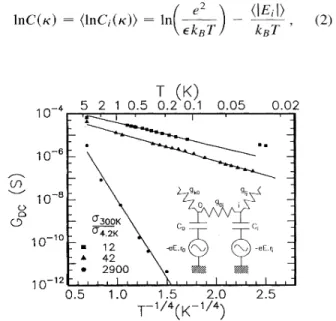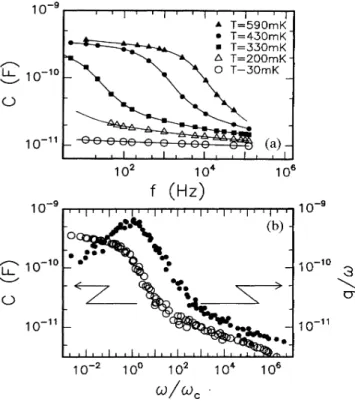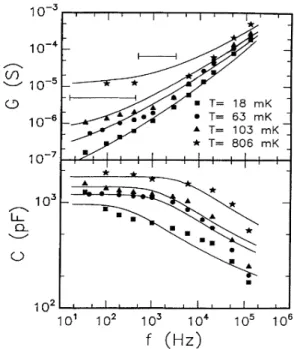HAL Id: cea-01396483
https://hal-cea.archives-ouvertes.fr/cea-01396483
Submitted on 14 Nov 2016
HAL is a multi-disciplinary open access
archive for the deposit and dissemination of
sci-entific research documents, whether they are
pub-lished or not. The documents may come from
teaching and research institutions in France or
abroad, or from public or private research centers.
L’archive ouverte pluridisciplinaire HAL, est
destinée au dépôt et à la diffusion de documents
scientifiques de niveau recherche, publiés ou non,
émanant des établissements d’enseignement et de
recherche français ou étrangers, des laboratoires
publics ou privés.
Magnetopolarizability at the Metal-Insulator Transition
Michael Specht, Laurent P. Lévy, F. Ladieu, M. Sanquer
To cite this version:
Michael Specht, Laurent P. Lévy, F. Ladieu, M. Sanquer.
Magnetopolarizability at the
Metal-Insulator Transition. Physical Review Letters, American Physical Society, 1995, 75 (21), pp.3902
- 3905. �10.1103/PhysRevLett.75.3902�. �cea-01396483�
VOLUME
75,
NUMBER 21PHYSICAL REVIEW
LETTERS
20NovEMBER 1995Magnetopolarizability
at
the
Metal-Insulator
Transition
Michael Specht and LaurentP.
LevyHigh Magnetic Field Laboratory, Centre National de la Recherche Scientifique/Max Plan-ck Insti-tut fur Festkorperforschung, Grenoble, BP266, F-38042 Grenoble, Cedex 9,France
and Universite
J.
Fourier, BP53, F-38042 St. Martin d'Heres, Cedex 9, France Francois Ladieu and Mare Sanquerd'Etudes de Saclay, F91791Gifsur Yvette, Cedex, France
(Received 27July 1995)
We have studied the ac response ofa series ofdisordered Y Si&
„
insulating samples in the vicinityof the metal-insulator transition. Far from the transition, the ac response is universal in frequency units scaled by a characterisitic frequency, ai,
=
g($,.)/C(g,.) governed by the critical conductanceg(g,) at the percolation threshold. A temperature-dependent characteristic field B, ~ T s, consistent
with interference effects, is identified. As the transition is approached, intermediate frequency scales are
stretched according to
5
ln(cu,)~ (Tp/T)'t4 We rela.tethis stretching tothe distribution oflocalizatic;ilengths at the transition.
PACS numbers: 71.30.+h
In 3D Anderson insulators, each electronic state is localized over a characteristic distance s
=
I/tc,
thelocalization length, as a result
of
interferences induced by disorder[1].
Numerical[2]
and theoretical[3]
studiesof
the Anderson transition have demonstrated that thevalues
of
the inverseof
the localization length ~ have a Gaussian distribution centered around(~)
=
I/(g),
deepin the insulating regime. As the metal-insulator (MI) transition is approached, the width
of
the distribution var[t~j becomes comparable to its mean (t~). In thisLetter, we demonstrate the experimental relevance
of
the distributionof
localization lengths at the MItransition.At zero temperature, ac conduction in an Anderson insulator can take place through the polarization current associated with the displacement
of
localized states. As the transition is approched, this "intrinsic polarizability"e;„,
diverges [4,5].
At finite temperature, there is anadditional contribution to the acresponse, because charges can hop from one state to another by phonon assisted
tunneling (Mott hopping). An occupied state, localized on
alength scale s
=
I/tc,
can make a few "optimal" hops to neighboring empty sites. These hops can be representedby bonds with a conductance
g(tc)
=
gpexp(—
[Tp(K)/T]'
InC(t~)=
(InC;(t~))=
ln 4ekpT kpT (2) T(K)
5 2 105
0201
005
I I I I I I I0.
02
10
'l0work: deviations are seen only at the lowest temperature on the sample closest to the transition. At finite frequency,
this network must be modified, since the electric field mod-ulates the occupation n; (and hence the charge
en;) of
states
(i)
close to the Fermi level. This introduces a capac-itance[8]
C;=
e tin;/ciV;=
e /4ekttT cosh(E,
/2kttT) between each node and ground as shown in the insetof
Fig. 1(e
is the dielectric constant averaged over the locali-zation length andF,
is the energyof
the state i measured from the Fermi level). The typical valueof
C for stateswith inverse-localization length
~,
10
—10 0 120.
51.
52.
02.
5 —1/4(
K—1/4)1.
0FIG. 1. Mott's law for samples with resistivity ratios
R(4.2 K)/R(300 K) of 3000, 40, and 12. The corresponding
values of To are 2940, 2 6, and 12 K. Inset: equivalent
impedance network at finite temperature.
=
gpexp(—
2~8ivt,«),
(1)
dependent on ~ through kttTp(~)=
18~ /n(eF)
These.
bonds form a Miller-Abrahams resistor network
[6].
When the bond conductances are distributed over a sufficiently broad scale, the overall conductance is dominated by the few bonds with inverse localization lengthK„which
estab-lish the sample-spanning cluster[7]
over the network. The overall conductance isof
the orderof
g(tc, ), yielding thewell-known Mott hopping law [Eq.
(1)].
Figure 1 showsVOLUME
75,
NUMBER 21PHYSICAL
REVIEW
LETTERS
20NovEMBER1995
is governed by the typical phonon energy absorbed in a
hop (~E,()
=
4k&Tp(Ir)' T3i . At finite frequency, thedisplacement current through the capacitors introduces a Mott contribution eM,« to the dielectric constant. Except
for samples far from the MI transition at the lowest temperature, &Mp«dominates ~;„,in most
of
the samples studied.The samples are prepared by argon sputtering a
Y,
Si~,
target (where0.
16(
x
(
0.
2) onto two inter-digited arrays forming the gold electrodesof
a capacitor,of
which theY
Si~ film is the dielectric medium. This amorphous material is known to be a good An-derson insulator with strong spin-orbit scattering due to the yttrium[9,
10].
In particular, the large electronic density at the Fermi level[n(eF)
=
7 X 104sJ
'm
at the critical concentration
x,
=
0.
18]
partially screens electron-electron interactions on distances short compared tos.
Finally, the typical valuesof
the localization length, 3(
(
(
40
nm, are much larger than all microscopiclength scales and can easily exceed the magnetic length
accessible in our laboratory. The frequency dependent capacitance and conductance are measured using a three
terminal capacitance bridge as in earlier studies
[11
—13]
in a dilution refrigerator.
Figure 2(a) shows the typical frequency dependence
of
the capacitance at different temperatures. The three curves taken at0.
59,
0.
4, and0.
33
K
differ only by the characteristic frequency cu, at which the capacitance drops, and can be overlapped by a simple translation on the logarithmic frequency axis, implying a universalfre
quency dependence
of
the acresponse. This is illustratedin Fig. 2(b), where nine data sets for the capacitance and
conductance taken at different temperatures and magnetic fields have been overlayed after rescaling the frequency axis by the characteristic frequencies. This frequency scaling involves a single parameter (iu,) instead
of
twoas observed in glasses
[14].
Such behavior can be accounted for
[8]
by applying an effective medium approximation to the impedance network shown in Fig.2(b).
The total admittanceof
all the bonds leaving site0
is replaced by a local effective admittance Y(cu).If
the network is locally homogeneous, its admittance seen from the neighboring sites i is also equal to Y(ru). Y(cu) can therefore be determined self-consistently. The equivalent admittanceof
all the bonds connected to site0
leaves its admittance Y(m) invariant:10-10 p 1
10
I k I l I I I I I I I I t I I T=590mK T—430mK 30mK 00mK-OmK(a)—
I i i I»
I t t I i i I10
10
f (Hz)
10
I I II I I I l II II l I II I I I t I I II I 4 II I 1u 1 1 1 Z+
(3)
Y(Kp, M) g(Kp) Y(Kp,Cd)+
Cr(Kp) dCwhere z is the effective number
of
bonds and the brackets represent an average over local disorder. This approach can be justified in a percolation picture, whereall the bonds
of
conductance g(
g(~,
) are removedand the bonds
of
conductance g)
g(~,
) are replaced by a conductance g(i~,),
effectively making the network homogeneous. Inthis case, there is only one characteristic frequencyIn[co,
(~,)]
=
lng(ir,
'
)=
const——
3 Tp(~,)0
10
10-10 10-11 0 1 110
10
10
Cd/Cd c I10
FIG. 2. (a) Frequency dependence of the capacitance of
samples deep in the insulating regime. A characteristic frequency can be identified as the inHection point. At 30mK,
the capacitance is frequency independent: Mott's polarizability
is quenched leaving only the "intrinsic" one. (b) Scaling plot
of the capacitance and conductance for the same sample as a function ofscaled frequency fornine different temperatures and
magnetic fields.
(4)
where g and C are defined in Eqs.
(1)
and(2).
At finite frequency, the current flows from site0
through the capacitor Co and in parallel through the network represented by the admittance Y(ir,cu). At frequenciessmall compared to
~„
the network current can only fiow through the critical conductances [Y(x.„cu)
=
g,
].
When cu exceeds~„
the capacitors allow the currentto be shunted to ground, effectively breaking the sample
in subcritical clusters which are divided further as the frequency increases. The overall frequency dependence
of
the local admittance is conveniently represented by the scaled admittance y(ru)=
[Y(tp)+
iCcu]jY(0),
which depends only on the scaled frequency0
=
ru/tu, . The self-consistent solutionof (3)
has been shown[8]
to be equivalent toylny
=iA
VOLUME
75,
NUMBER 21PH
YS
ICAL
REVIEW
LETTERS
20NovEMBER1995
as long as Intel
«(To/T)'t
. For insulating samples far from the transition, the percolating bonds dominate the impedance network and the sample conductance is pro-portional toy(rr„or).
At low frequency (static limit),y
=
exp(iA),
the capacitance and the conductanceof
the network are constant. At high frequencies(II
»
1),y
=
iA/In(iA),
yielding a sample conductanceRe(g) ~
Re(y)
=
(~/2)A/[InA]2
increasing sublinearly with fre-quency and a capacitance C~
Im(y)/0
=
I/InfI
de-creasing logarithmically with~,
in excellent agreementwith the data shown in Fig.
2(b).
At the lowest tem-perature[30
mK, Fig.2(a)],
the capacitance reaches a frequency independent limit, indicating that the intrinsic polarizability takes over Mott scontribution.In these samples, a magnetic field can induce a large change in eM,
«,
which saturates at sufficiently high field(cf.
Fig.3).
Since data taken in a field can be overlaidon the same universal plot [Fig.
2(b)],
this dependence ispurely dynamical and can bedescribed by a magnetic field dependence
of
cu,. This dependence may be attributed to a magnetic field dependenceof
rr, (see below). Since~,
is here proportional to the static conductance, mag-netocapacitance and magnetoconductance are related to one another. In particnlar, the negative magnetoconduc-tanceof
these samples[9]
is entirely consistent with the decreaseof
~,
with magnetic field. At high tempera-ture or frequencies small compared toco„
the response is static, and changes in characteristic frequencies have little effect on the capacitance[cf.
Fig.2(b)].
When oris comparable to
~„a
change in cu,of
approximatively one decade is sufficient to go from the low to the high fre-quency regime. This produces a purely dynamical capaci-tance dropof
an orderof
magnitude. At low temperature or high frequency, changes in cu, have only logarithmic effects[cf.
Fig. 2(b)]on the capacitance.An important field scale, however, can be identified from Fig.
3.
For all temperatures, one can define thecharacteristic field
B,
for which the capacitance changeC(0)
—
C(B)
is halfof
its total variationC(0)
—
C(~).
The resulting plot
of
B,
as a functionof T,
shown in the insetof
Fig. 3 is a power law with an exponent close to1/2.
This means that the productB,
SM.„=
B,
—
—
To=
1.
3 X10
"Tm'
=
0.
33eo
I I ) I I J I I ) I I ( I10
V)10
10
mK mK mK mK(6)
is a constant, which, from the experimentally determined
value
of
To and s(cf.
Fig.1),
isof
the orderof
the flux quantum. This relates directly to the observed magnetocapacitance to quantum-interference effects in an
area limited by ZM,
«[15].
In insulators, this length plays the roleof
the phase-coherence length since the phonon absorbed in a Mott hop is an inelastic process[16].
Samples close to the MItransition have a different be-havior. Figure
4
shows the frequency dependenceof
the conductance and capacitance very close to the MI tran-sition. Although the high temperature curve resembleswhat is shown in Fig. 2(a), one observes a stretching
of
the intermediate frequency scales (crossover region) asthe temperature is lowered. We previously showed that the
high frequency conductance is the sum
of
the admittance from independent conducting clusters. When the network is very inhomogeneous, as is the case close to the MI transition, the local admittance Y(rr,or) fluctuates from cluster to cluster.If
each island is considered ashomo-0.
0
I I I I I I I I I i I I I I I I I I I I I ) I I J I I ) I I ) I I*
—
0.
2~
—0.
40
8 I I I I I I I I I 1 I I I I I I I I I0
510
15
20
H(Tesla)
FIG.3. Magnetic field dependence of the capacitance
(mea-sured at fixed frequency) of samples deep in the insulating
regime at four different temperatures. Inset: Temperature de-pendence ofthe characteristic field
8,
.102 I I I I I I I I l
10
10
10
10
I I I I
FIG.4. Frequency dependence of the conductance and the
capacitance close to the metal-insulator transition. The solid
lines are fits to the model discussed in the text. The line
segments are scaled by the temperature ratio (0.806/0. 103)'t
VOLUME
75,
NUMBER 21PH
YS
ICAL
REVIEW
LETTERS
20NovEMBER1995
geneous, with an inverse localization length sc, the overall conductance is the average
of I'(tc,
co)over a relevant dis-tributionof
inverse localization length 2 (tc). Hence, thefrequency dependence
of
the normalized complex conduc-tanceg(co)/g(0)
is approximativelyg(co)/g(0)
=
2 (tr)y(tc, co)dtc.
(7)
0
A phenomenological distribution
[17]
param-etrized by its mean value (tc) and its widthvar[tc], 2
(v) ~
tc'exp(—
z(tc—
(tc)) /var[t~]) is used tofit the experimental data. The width vat[tc] reproduces the temperature-dependent frequency stretching
of
the crossover region. After differentiating Eq.(4),
the vari-ance in characteristic frequencies isvar[in co,
]
=
i6[To((tc))/T]'
var[tc]/(t~),(8)
which spreads on a logarithmic scale as
(To/T)'l
. This is illustrated in Fig. 4, where two line segments stretchedby the temperature ratios
(0.806/0. 103)'t4
=
1.
7of
two different conductance curves reproduce the stretchingin the crossover region. Equations
(5)
and(7)
define the solid line fits shown in Fig. 4 using the followingfitting parameters: (a) the average localization length
(g)
=
I/(tc)
=
30
nm and the conductance prefactor goare determined by the temperature dependence
of
the conductance(cf.
Fig.1),
(b) the dielectric constant e=
500
sets the overall frequency scale, and(c)
the widthvar[tc]
=
0.
3(tc).
No other parameters are necessary to reproduce the magnitudeof
the capacitance. The overall behavior is well reproduced, except for a slower dropof
the capacitance in the high frequency regime. This is not surprising, considering (a) the limited validity
of
Eq.(5)
close to the MI transition and (b) the roleof
the intrinsic polarizability which was left outof
the analysis.The overall frequency dependence in large magnetic fields (not shown) has the same shape as the dependence
in zero field but
at
a
lower temperature. For example, ina field
of
7 T,the effective temperature drops roughly bya factor
of
2.
This is not only apparent in the smaller dc valueof
the conductance (negative magnetoconductance),but also in the additional stretching
of
frequency scales observed in the frequency dependent capacitance. Sev-eral interpretations may be considered. This "effective cooling" in the ac response can be mimicked either by a reductionof
the average localization length [increasing (tc)=
I/($),
seeEq.(4)]
orby an increase in the widthof
the distribution var[tc]
[cf.
Eq.(8)].
The observed "cool-ing" in a fieldof
7T
can be reproduced by a20%
to30%
change
of
(tc), or by a15%
to20%
increaseof var[K].
Such significant changes (considering that they come in
the exponent for most experimentally accessible quanti-ties) are consistent with interference effects in Anderson insulators with strong spin-orbit scattering
[10].
If
the MI is driven only by disorder, a one-parameter scaling theory[1]
isapplicable and changes in var[tc] and (tc)are relatedand occur sirnultanously.
In conclusion, the ac response
of
Anderson insulators is sensitive not only to the zero-temperature displacement current, but also to an activated or"Mott"
polarizability. The frequency dependenceof
the real and imaginary partof
the conductivity probes the relevant length scales inthe problem. Deep in the insulating regime, the locali-zation length is the only relevant length scale observed. A temperature-dependent characteristic magnetic field can be identified, consistent with interference effects within
the Mott hopping length. We relate the observed
stretch-ing
of
the frequency scales close to the MI transition to the distributionof
inverse localization lengths at the tran-sition. A magnetic field modifies this distribution, but it is at present not possible to distinguish between a shift or a broadeningof
the distribution.We wish to thank the
DRET
for financial support under Grant No.92/181.
Oneof
us (M. Sp.) acknowl-edges financial support from the DAAD foundation (HSPII/AUFE program).[1]P. W. Anderson, Phys. Rev. 109, 1942 (1958); E. Abrahams, P. W. Anderson, D.C. Licciardello,
and T.V.Ramakrishnan, Phys. Rev. Lett. 42, 673
(1979).
[2] P.Markos and
B.
Kramer, Philos. Mag. B68, 357(1993).
[3] J. L.Pichard, in Quantum Coherence in MesoscopicSys-tems, edited by
B.
Kramer, NATO ASI Ser. B,Vol. 254(Plenum Press, New York, 1991),p. 369.
[4] Y. Imry, Y. Gefen, and D. Bergman, Phys. Rev. B 26, 3436(1982).
[5]M.A. Paalanen, T. F. Rosenbaum, G.A. Thomas, and R.N. Bhatt, Phys. Rev. Lett. 51,1896(1983).
[6]A. Miller and E.Abrahams, Phys. Rev. 120, 745 (1960). [7]V. Ambegaokar,
B.
I. Halperin, andJ.
S. Langer, Phys.Rev. B4,2612
(1971).
[8] S.Summerfield and P.N. Butcher,
J.
Phys. C 15, 7003 (1982);V.V. Bryskin, Fiz. Tverd. Tela (Leningrad) 22, 2441 (1980) [Sov. Phys. Solid State 22, 1421(1980)];
B.
Movaghar and W. Shirmacher,J.
Phys. C 14, 859(1981).
[9]P. Hernandez and M. Sanquer, Phys. Rev. Lett. 68, 1402 (1992).
[10] J. L.Pichard, M. Sanquer, K.Slevin, and P.Debray, Phys.
Rev. Lett. 65, 1812(1990).
[11]
M. Pollak and T.H. Geballe, Phys. Rev. 122, 1742(1961).
[12] T.G.Castner etal., Phys. Rev. Lett. 34, 1627(1975).[13]
A.R. Long, in Hopping Transport in Solids, edited byM. Pollak and
B.
Shklovskii (Elsevier, New York, 1991),p.207.
[14]P.K. Dixon, L. Wu, S. Nagel,
B.
D. Williams, and J.P.Carini, Phys. Rev. Lett. 65, 1108(1990).
[15]
B.
I.Shklovskii andB.
Z.Spivak, in Hopping Transport in Solids, edited by M. Pollak andB.
Shklovskii (Elsevier,New York, 1991).
[16]
F.P.Milliken and Z. Ovadyahu, Phys. Rev. Lett. 65, 911 (1990).[17]Mott's law requires that 2 vanishes sufficiently rapidly as K


